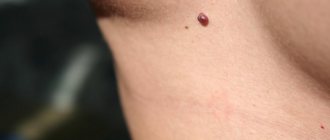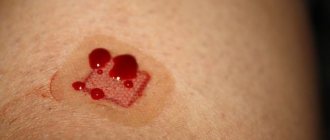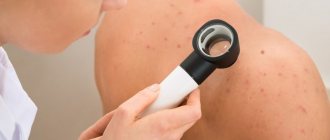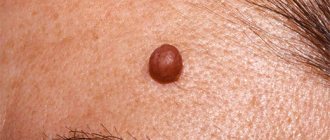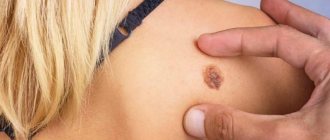It often happens that we injure moles. Rip off completely or slightly tear off from the skin. It happens that the bleeding is quite strong, but it is still possible to stop it. Here the mole is covered with a band-aid and everything seems to be fine. Here we remember that in childhood our mother told us: “Don’t pick at a mole - you can die from it.” With an unpleasant feeling somewhere in the upper abdomen, we begin to search on the Internet for the eternal answer to the question “What to do?” After half an hour or an hour we understand that in a couple of days death from melanoma will occur and it’s time to look for a place in the cemetery...
Later in this article I will try to interrupt the endless stream of hysteria that has been copied from site to site for many years
Sign up for the webinar “Carcinogens in cosmetics: truth, lies and... marketing”
Is mole injury really dangerous?
In RuNet, the danger of traumatizing moles is given excessive, in my opinion, importance. Is there any justification for this point of view? Absolutely, but I think it's quite shaky.
Indeed, there are several studies on this issue, mostly conducted in the 60s–80s of the last century. They show that 30–50% of patients in whom melanoma developed against the background of a nevus noted single or repeated trauma to the mole.
There are several arguments against these studies:
- Just because melanoma develops after trauma to a nevus does not necessarily mean that the two are related. Melanoma could develop both before trauma and much later for other reasons .
- A 2010 meta-analysis (summarizing data from 9 studies) showed that performing an incisional biopsy does not affect the prognosis of melanoma. In other words, if a piece is cut off from melanoma (for diagnostic purposes), this will not negatively affect the patient’s chances of living 5 years or more.
- The conclusions of the authors of several studies (55, 115, 147 and 498 patients) agree on one thing - incomplete removal of nevi, except for dysplastic ones with severe dysplasia, does not lead to the development of melanoma.
Here the corrosive reader will say: “Aha! Still, incomplete removal (you can read “trauma”) causes the development of melanoma!” No. A dysplastic nevus with severe dysplasia itself has a high chance of becoming melanoma in the future. The connection between incomplete removal and the development of melanoma from such nevi has not been proven .
- My experience. Almost every day people write to me who have injured a mole and are now preparing to “die” because they have read too much on the Internet. Almost any person who has a mole protruding above the skin has injured it in one way or another at least once in their life. If trauma to a mole were really a risk factor, in our country with a population of 146,000,000, the diagnosis of melanoma would be made much more often than 8,000 times a year.
Injury to a mole: consequences
First of all, it should be noted that the development of melanoma is not always associated with damage to pigmented nevi and will not necessarily be a consequence of such a process. At the same time, doctors have proven that for moles that are initially classified as melanoma-hazardous, any trauma to their surface can lead to accelerated development of the cancer process. This is one of the main reasons why any nevi should be protected from aggressive damaging influences.
In addition to malignant transformation, we can identify several more unpleasant and dangerous consequences that a torn or torn off mole can entail:
- Heavy bleeding. The body of the nevus feeds many blood vessels and capillaries, which saturate the formation cells with oxygen and nutrients. Some moles, such as angiomas and hemangiomas, are composed entirely of a tangle of blood channels. It is in this regard that if a mole is damaged, severe bleeding can develop, which can most often be stopped only with the help of professional medical care. After visible healing, the mole often bleeds for a long time, which is a residual consequence of the injury.
- Attachment of infection. An open wound that forms at the site of a damaged nevus provides rapid access for infectious agents to the wound surface and, accordingly, to the entire patient’s body. As a result, not only a local infectious process can develop, but also a generalized pathological condition, accompanied by suppuration of the primary site of contamination.
- Inflammatory process. Often after mechanical trauma to a nevus, patients note swelling of the area around the mole and some hyperemia of the skin. This, together with pain when pressed, may indicate the development of inflammation. Such a reaction is sometimes accompanied by vasospasm, which is manifested by the appearance of a white spot around the torn mole. In the absence of professional medical care, such a process can also lead to suppuration of the wound.
- Formation of scars and scars. This aspect is especially concerning for the fair sex, because a situation where a woman scratches a mole on her face with a massive accessory or manicure is not uncommon. The consequence of such a careless attitude towards a nevus can be an undesirable aesthetic defect, which is formed against the background of excessive formation of connective tissue. In the future, such scars and scars can only be removed using hardware cosmetology techniques.
In order to avoid all these unpleasant phenomena, it is recommended to treat existing moles with care and attention and remove a defect located in an area of increased risk of injury in advance.
What will happen to the mole next?
After trauma, as in any other place, the mole will hurt a little and turn slightly red - this is normal. Gradually, after 2-3 weeks, these phenomena should go away on their own. The only situation in which medical intervention may be required is the suppuration of a mole after a severe injury. This means that if after a few days a viscous white (not yellow) liquid begins to come out from the site of injury, you need to be examined by a surgeon. After 1-2 days, a crust will appear at the site of the injury, which will fall off on its own after 1-2 weeks.
Actions to take if a mole is damaged
Actions to take when a mole is injured depend on the nature of the damage. If the mole is slightly scratched, but there is no blood, then it is enough to wash it with an antiseptic solution. It is not necessary to see a doctor.
If there is bleeding from a mole, the following measures must be taken:
- treat the wound with an antiseptic (excluding iodine);
- moisten a cotton swab with hydrogen peroxide and apply to the mole;
- When the bleeding stops, apply a bandage.
If the mole is severely torn, then you need to go to the clinic and have the tumor completely removed. After this, it is advisable to submit the biomaterial for histological examination. If the mole has fallen off completely, then it should also be sent for histology. But melanoma does not develop so quickly, and its first signs appear about a month after the mole is injured, so it would be best to undergo a re-examination.
How to properly monitor a mole after an injury?
To objectively track changes in a mole, after the inflammation has subsided, you can take a photograph of it against the background of a ruler and compare the original image with subsequent ones. In order for the photo to be of high quality and comparison possible, the following rules must be observed:
- The photo must be taken with a camera, not a phone.
- The photo should not be a “selfie”. In such photographs, the mole is usually out of focus.
- A light source or camera flash should be directed at the mole.
Peculiarities
Moles are not inherently dangerous. They arise due to disruptions in the distribution of the top layer of skin cells. In medicine, pigment spots in the form of a tubercle are called nevi. Most often they are found on the face.
The reasons for their occurrence on the body:
- Heredity - a mole on one part of the body can be transmitted through genes;
- Excessive production of melanin when a person spends a lot of time in the sun;
- Hormonal disruptions - they cause not only the appearance of new formations, but also the disappearance of old ones;
- Stress;
- Radiation;
- Viral diseases;
- Injuries.
Briefly about the main thing:
In my opinion, there is currently no convincing evidence that trauma to a mole can lead to the development of melanoma. Besides me, oncology associations such as NCCN and ESMO also think the same. However, I don’t know if everything was fine with your mole BEFORE the injury. That is why, after the inflammation has subsided, I recommend contacting an oncologist, especially if this specialist has not looked at all of your moles before. If pain, redness, and swelling do not go away within a month, you need to see an oncologist as quickly as possible.
If you still have questions, the following will help you:
- In-person appointment with an oncologist
(St. Petersburg) - Mole removal
with histology (St. Petersburg) - My Online consultation (from anywhere in the world)
Doctors all over the world do not recommend removing moles, and if you do this, be sure to contact a specialist who, using modern laser equipment, will remove the mole without side effects. Nowadays, this is quite convenient because the laser mole removal procedure: Read: Skin Cancer – Everyone Should Know About This * does not take much time; * does not require sick leave; * affordable; * and most importantly, painless. If moles are located on the body in places that rub against clothing or the mole can easily be caught with a hand, razor, or comb, then it is better to use the laser removal procedure. Read: Oncologist. Oncologist You need to know that a mole in medicine has the terminology “nevus” and is a benign formation (i.e., a kind of tumor) that does not grow and this is its main difference from other types of tumors. However, if for some reason the mole is damaged, and the person does not pay due attention to it and does not react, then the process of forming a real cancerous tumor “melanoma” begins. Melanoma is extremely dangerous because it grows extremely quickly and quickly enters the metastasis phase. Read: Mole or skin cancer? Are you in doubt the whole way? What to do if a mole is damaged 1. Stop the bleeding using a tampon or cotton wool, after moistening it with hydrogen peroxide. You can also use dry gauze: fold it in several layers and press it onto the affected mole. The gauze should be kept for 10-15 minutes. 2. If the mole is not completely torn off, then you need to follow the first step (stop the bleeding) and go to a medical facility as soon as possible. The doctor will remove the remnants of the mole efficiently and safely to avoid infection. The hospital will then conduct special tests to determine whether the tumor is benign or malignant. Read: Papillomas – are they dangerous!? 3. If the mole comes off completely, the torn nevus must be preserved by placing it in saline solution. An avulsed mole is very important for examination and analysis of the quality of the tumor. So, if a mole is torn , torn off, or damaged in some way, this fact should under no circumstances be ignored. It is extremely important to stop the bleeding and seek immediate medical attention. Despite the fact that a mole or birthmark is a benign tumor, you should not treat it with disdain, since any damage to it may well result in death! How to understand whether a mole is melanoma If for any reason a mole has been torn off, you need to observe the skin in its place to see if it has become darker or if its structure has changed. If after treatment the mole increases in size or begins to bleed again, then most likely it is melanoma. This causes an aching and dull pain. Don’t put off your visit to the surgeon! Read: Early signs of cancer There are cases when a mole spontaneously began to change, without being disturbed or damaged at all, but it’s still worth going to the doctor. You need to be especially concerned if a mole, without any justified reason, begins to: * change shape or size; * itch; * become inflamed; * change color; *bleed. How to protect yourself Tips on how to protect yourself from picking off moles are quite simple and acceptable for any person. All you need to do is: Read: The scary word melanoma 1. Maintain the hygiene and aesthetics of your hands and nails. Nails should be clean, polished and neatly trimmed. You should not grow very long nails if there is a mole on your body in an accessible place, which can be easily torn off if you are careless. 2. Choose loose clothing that will not touch the mole. When choosing clothes, you must take into account the factor of “friction” of clothes against moles. It’s better to give up this dangerous wardrobe item. Read: Ultrasound. Ultrasound diagnostic doctor 3. Sometimes excessive diligence in maintaining body hygiene can play a “wicked joke” and cause a mole to be ripped off. Therefore, when bathing, you must be extremely careful not to damage the mole. The same applies to the use of scrubs. Replace hard washcloths with soft shower sponges, and carefully avoid areas with large, sensitive or hanging moles. You also need to dry yourself with a towel as carefully as possible. Read: What is basal cell carcinoma? CONCLUSION: The vast majority of various damage to moles occurs due to our negligence! A mole is an integral part of our body and requires care and special treatment! We must always remember that our body and health are our main resource for health, a successful and happy life! Book a consultation by phone in Taganrog
Doctors' visiting hours are from 10.00 to 17.00.
Saturday - from 10.00 to 13.00
License No. LO-61-01-003776
Material prepared by Natalya KOVALENKO. Website illustrations: © 2014 Thinkstock.
Treatment
When a person scratches a mole until it bleeds, in modern clinical medicine these problems are solved in several available ways:
- electricity;
- laser removal;
- cauterization.
Together with any of the methods described above, the patient can get rid of nevus on the skin and eliminate the pain that is often observed with injuries and diseases of moles.
So, I scratched the mole until it bled. The doctor will tell you what to do.
In what cases is it necessary to remove an injured nevus?
The injured growth must be urgently shown to a specialist and removed if it is very painful, brings discomfort, has changed color, shape and size, bleeds, itches, or discharge appears in the form of pus and ichor.
A damaged nevus does not always develop into cancer; it depends on its individual structure. After treatment or removal of a torn mole, experts advise monitoring it and if there is the slightest change in the damaged area of the dermis, go to the hospital.
To ensure prevention of injury to warts and birthmarks, you should not scratch them, wear comfortable, loose, well-tailored clothes without rough seams, use soft washcloths, and pat the skin with a towel rather than rubbing it. If formations are injured, do not self-medicate.
The appearance of a crust on a mole
The growth on the nevus may be white or brown. This crust appears when there is an injury or burn. If a mole begins to crumble, the result may be skin cancer. You cannot peel off the crust yourself, as this can lead to infection of the skin. To exclude nevus transformation, it is necessary to undergo dermatoscopy by a dermatologist or oncologist. This is the diagnosis of skin lesions using special optical equipment - the procedure is absolutely painless, does not require preparation and takes no more than 10 minutes.
If the doctor finds suspicious symptoms, a biopsy will be required. In this case, a small area of skin is taken for analysis in the laboratory.
Where does a mole begin?
Nevus is considered a benign skin neoplasm, characterized by an accumulation of nevocytes, melanin-rich cells.
This is why the mole has a dark color and fairly clear boundaries.
The transformed melanocytes (nevocytes) take up the thyroid hormone thyroxine and transform it into melanin, which colors the skin in a certain area.
Melanin is necessary for the human body.
It is both an antioxidant and a predictor of anti-stress hormones, softening emotional reactions, and a regulator of sleep and wakefulness.
To be or not to be a mole is determined in the embryonic period, even if the pigment formation appeared after birth.
Some features of pregnancy stimulate the process of melanocyte transformation.
The nevocyte does not have processes, therefore, like a stingy knight, it accumulates all the melanin without giving it to other areas of the skin. You can be born with moles or acquire them during periods of hormonal crises: puberty, pregnancy, menopause, unsuccessful selection of contraceptives.
As well as intense tanning, including in solariums, skin infections, allergies.
Nevocytes form a border nevus at the border of the superficial and deep layers of the skin. then grow into the dermis (mixed or intradermal nevus).
A border nevus is a round, dark, smooth spot.
The mixed one protrudes slightly above the skin.
An intradermal nevus looks larger, rising like a dome on a small stalk, sometimes with hairs, that is, it looks like a dark wart.
The main danger of a nevus is that its cells can become malignant and malignant.
Melanoma, a very dangerous malignant skin tumor, can develop from a melanocytic nevus.
80% of deaths from skin cancer occur with melanomas, although almost all patients who receive timely treatment live quietly for 10-15 years before a new relapse.
Risk factors for malignancy are known.
These are heredity (melanoma or other oncology), ultraviolet radiation (permanent or excessive tanning), sunburn, fair skin and red hair.
Gella, the heroine of The Master and Margarita, could have a predisposition to melanomas.
Let's look at some complaints related to moles.
Symptoms of violation of the integrity of a mole
If painful sensations or a feeling of discomfort appear, it is necessary to urgently take measures aimed at establishing the causes and further treatment of the phenomenon on the epidermal surface. Several of the most common symptoms of general nevus disorders:
- the skin has uneven edges around the formation;
- signs of asymmetry in the shape of the mole appeared;
- the color of the nevus has changed;
- increase in size of formation;
- the occurrence of pain or discomfort.
How to treat a skinned mole?
To prevent the inflammatory process, the affected area is treated with an antiseptic.
Hydrogen peroxide, chlorhexidine, manganese solution, and alcohol are suitable. When using iodine and brilliant green, you should avoid getting them into the wound itself and apply it along the edges. If pharmaceuticals are not at hand, for example, in the forest, you can use natural antiseptics. These include salt, soda, lemon, onion, garlic. Plants include plantain, chamomile, and pine resin. First aid:
- Stop the bleeding. To do this, wet a cotton swab with hydrogen peroxide and apply it to the affected area for 15-20 minutes. If there is heavy bleeding, change the tampon periodically. If the bleeding does not stop, call an ambulance.
- When the blood stops coming out, cover the wound with a bactericidal bandage. If you only have a regular plaster at home, then first apply cotton wool soaked in an antiseptic.
- The torn area or the entire mole must be preserved in saline solution. Regular saline solution will also work. This material will be needed to examine the mole for the presence of cancer cells.
- After treating the affected area, see a doctor. If necessary, a specialist will prescribe treatment. In some cases, the remaining portion of the growth is removed.
If a child accidentally picks off a mole , first aid is provided in the same way. It is better to wrap the patch with a bandage so that the child cannot peel it off. An important step is to explain to children that picking and scratching moles is dangerous and that care should be taken with these areas of skin.
Even at an early age, melanoma can develop, so a visit to a specialist should not be delayed.
Which doctor should I contact if I tore a mole?
Diagnosis of a damaged mole is carried out by specialists:
- Dermatologist;
- Surgeon;
- Oncologist.
After examination and histological analysis, the doctor recommends special treatment or removal of the mole.
First they visit the surgeon . If necessary, he will refer you to other doctors.
Self-medication is unacceptable
When a child scratches a mole, trying to treat it yourself is highly inadvisable, since such procedures can cause serious harm by introducing infection into the damaged area. The main complication in this case is the development of malignant processes, which are caused by pathological transformation of the cellular structures of the nevus.
It is for this reason that every person, if possible, should visit a doctor who will carry out the necessary diagnostic measures to examine the mole, which will help identify the presence of certain diseases.
Why do moles fall off?
First you need to find out whether it was a mole. Perhaps it was another formation: age spots, crusts due to injuries, in places of scratching, fungal infections, etc. can form on the skin. Since not every nevus is convex, a mole cannot fall off on its own, because the formation is part of the skin. Formations on the skin that tend to fall off are called keratomas. They are darker than nevi. The older the person, the greater the likelihood that the keratoma will fall off. But if it turns out that it is the mole that has fallen off, then you need to identify the reasons:
- Hormonal surges.
When hormonal imbalance occurs, a mole forms. When it normalizes, the mole dies. Such phenomena are not uncommon during age transitions, during pregnancy, or when taking hormonal medications. - Traumatic factors.
Excessive tanning in direct sunlight, cuts to the mole, or friction of clothing against the nevus can cause the mole to peel off. - Necrosis.
The formation will fall off if it does not receive the substances necessary for normal functioning. For example, long moles are at risk: they become twisted, blood flow is disrupted and the nevus dries out. - Tumor.
The mole causes discomfort, itches and develops into melanoma. Cellular growth occurs, the mole dries out and falls off. This is the most dangerous reason.
Removal techniques
If the doctor decides to remove a mole, this can be done using the following modern techniques:
- surgical removal;
- removal with nitrogen (cryodestruction);
- electrocoagulation;
- laser therapy;
- radio wave excision – getting rid of a mole using high-frequency waves.
Surgical removal is considered the most reliable method for removing damaged moles. The surgeon cuts off the formation with a scalpel and cauterizes the wound. Then an antibiotic and a special bandage are applied to the surface. Sometimes the mole and its surrounding surface are removed. The size of this area affects the possibility of developing a malignant process. After cutting out large areas, stitches are placed.
The cryodestruction method is used for small moles and papillomas in prominent places. Using an applicator, liquid nitrogen is applied to the mole, where a bubble appears. It subsequently shrinks and forms a crust, which then falls off and new skin remains in place. Dermatologists confirm this. What to do if you scratch a mole, you should first check with them.
Electrocoagulation fights annoying moles, warts, HPV, acne and many other ailments. When removing a mole with an electric coagulator, the specialist selects the power of the device and, using a loop-tip, begins to influence the mole through an electric current.
Laser therapy is suitable for removing small tumors. Today, this procedure is recognized as the most effective method for removing a mole on the face. Its essence is the complete elimination of education. To remove a mole without damaging surrounding areas of the skin, a beam with a certain wavelength is selected. Its effect is aimed at melanin, which is contained in moles.
Why should you see a dermatologist?
Moles are benign neoplasms, but they can provoke the development of melanoma under the influence of a number of negative factors. Damage is one of them. If the nevus is very itchy, this may indicate that its cells have begun to become malignant. Only a dermatologist can exclude the development of cancer during an in-person examination.
Since damage to nevi is very dangerous, doctors advise removing large tumors in advance, the risk of injury to which is very high. Modern dermatologists use a laser or radio wave knife to carry out this procedure. Are you looking for where to undergo laser mole removal on Bratislavskaya? You can get a consultation with a qualified dermatologist in our clinic. The specialist will tell you in more detail about existing methods of excision of nevi and help you choose the safest option.
All articles
5% discount Print coupon from our website
Ask your question on the website Get professional advice!
